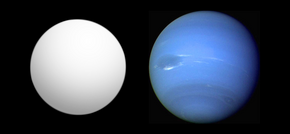 Size comparison of Kepler-11 d (gray) with Neptune. | |
| Discovery[1] | |
|---|---|
| Discovery date | 2 February 2011[2] |
| Transit (Kepler Mission)[2] | |
| Orbital characteristics | |
| .159 AU (23,800,000 km)[3] | |
| 22.68719[3] d | |
| Inclination | 89.3[3] |
| Star | Kepler-11 (KOI-157) |
| Physical characteristics | |
| 3.43 (± .32)[1] R🜨 | |
| Mass | 6.1 +3.1 −1.7[1] ME |
Mean density | 0.9 g/cm3 (0.033 lb/cu in)[3] |
| Temperature | 692 K (419 °C; 786 °F)[3] |
Kepler-11d is an exoplanet discovered in the orbit of the sun-like star Kepler-11. It is named for the telescope that discovered it, a NASA spacecraft named Kepler that is designed to detect Earth-like planets by measuring small dips in the brightness of their host stars as the planets cross in front. This process, known as the transit method, was used to note the presence of six planets in orbit around Kepler-11, of which Kepler-11d is the third from its star. Kepler-11d orbits Kepler-11 well within the orbit of Mercury approximately every 23 days. The planet is approximately six times more massive than the Earth, and has a radius that is three and a half times larger than that of Earth's. It is, however, far hotter than Earth is. Its low density, comparable to that of Saturn, suggests that Kepler-11d has a large hydrogen–helium atmosphere. Kepler-11d was announced with its five sister planets on February 2, 2011 after extensive follow-up studies.
- ^ a b c Cite error: The named reference
Lissauer2011was invoked but never defined (see the help page). - ^ a b Cite error: The named reference
Space.comwas invoked but never defined (see the help page). - ^ a b c d e Cite error: The named reference
datatablewas invoked but never defined (see the help page).